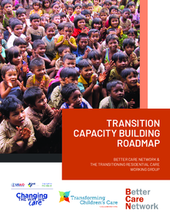Strengthening the foundation for transition
Before commencing with the implementation phase, many organizations find they need to strengthen their governance and accountability systems in order to get ready for the added complexity transition introduces and to ensure that any issues arising throughout the implementation phase can be dealt with appropriately and in a timely manner. This is a significant part of risk management in transition as many risks stem from a lack of structure at the organizational level and escalate when the lack of structure leaves organizations with no effective means of resolving the issues when they first come to light. The escalation of these issues can very easily begin to impact children and/or their families and derail the whole transition.
The aim of this stage is therefore to address any critical gaps or issues identified during the organizational assessments and governance audit/review.
This stage is concerned with developing or strengthening policies, procedures and reporting systems.
Activities that may occur during this stage are driven by the findings of the organizational assessments/review and may include:
- Developing or updating organizational policies including:
- Child Safeguarding/Child Protection Policies, including conducting new risk assessments taking into account transition related risks
- Complaints Handling Procedures, ensuring there is clarity around staff disciplinary and complaints handling procedures
- Admission/Gatekeeping Policies
- Staff or HR manuals/handbooks outline clear expectations and procedures
- Visiting and Volunteering Policy
- Financial Policies and Reporting Procedures
- Addressing gaps in the governance framework, which could include:
- Clarifying the legal status of boards and formalizing boards where they have been otherwise informally operating
- Strengthening the governing document (i.e. constitution)
- Securing any outstanding registrations or licenses with government
- Clarifying high-level decision-making structures and procedures
- Managing any outstanding legal issues
- Ensuring all key legal documents are appropriately held (land titles, leases, assets, agreements, registration and licensing documentation)
- Securing/verifying the status of staff contracts and agreements:
- Ensure staff contracts are signed and on file
- Ensure child protection policies, codes of conduct and other staff policies are signed and on file
- Developing or strengthening child friendly procedures
- Child and youth participation mechanisms
- Child friendly reporting mechanisms
Key milestones associated with this step are, the transitioning organisation has:
- Adequate governance framework in place to proceed safely with transition
- Adequate financial management systems in place
- Adequate staff management and accountability frameworks in place
- Clear reporting systems in place
- Clear leadership and decision-making structure in place for the transition process
Resources
Displaying 1 - 2 of 2
This document outlines a capacity-building roadmap for scaling up the transition of residential care services. It is an interagency resource developed by Better Care Network and the Transitioning Residential Care Working Group (Transforming Children's Care Collaborative).
Catholic Relief Services’ (CRS) Holistic Organizational Capacity Assessment Instrument (HOCAI) is designed to assist organizations to conduct a self analysis of their strengths and challenges, develop an action plan, and improve organizational functions through capacity strengthening. With HOCAI, CRS creates a standardized framework to help organizations engage in a process of continuous assessment and improvement that will sustain organizational capacities.


